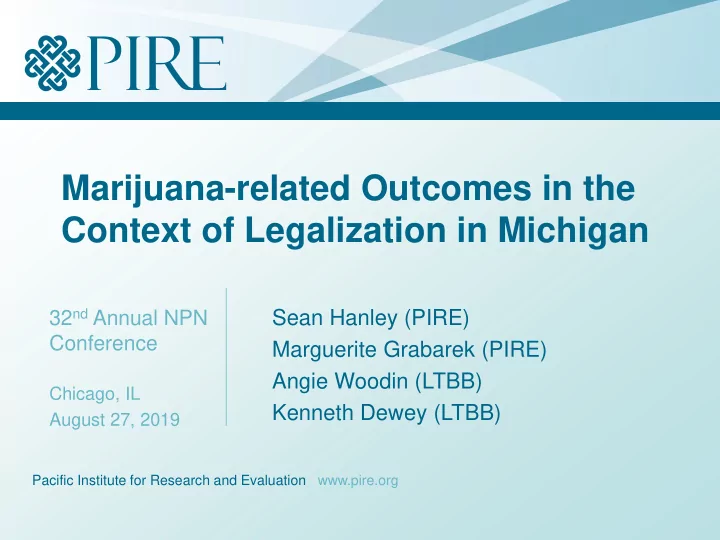

Marijuana-related Outcomes in the Context of Legalization in Michigan 32 nd Annual NPN Sean Hanley (PIRE) Conference Marguerite Grabarek (PIRE) Angie Woodin (LTBB) Chicago, IL Kenneth Dewey (LTBB) August 27, 2019 Pacific Institute for Research and Evaluation www.pire.org
3 Objectives: 1. LTBB at a glance 2. A brief history of marijuana legalization in Michigan 3. Trends in marijuana use and related risk factors among LTBB youth and adults
LTBB at a Glance • LTBB is a federally-recognized tribe reaffirmed Sept. 1994. • Most of 4000+ tribal members live in the NW corner of the lower peninsula of MI. • Although the tribe has a designated reservation encompassing portions of Charlevoix and Emmet Counties, most tribal members live on non-tribal lands. • Tribal health department serves a 27-county area in northern LP and eastern UP.
27-County Service Area
Population Density Source: geo.msu.edu/extra/geogmich/populationchanges.html
Petoskey (L) and Harbor Springs (R)
2. A Brief History of Legalization in MI 1972-2018: Decriminalization at municipal level 2020: Nov. 2008: 2012: Feb. 2013: Nov. 2018: Retail Michigan First attempt to MI Supreme Court Michigan environment Compassionate get recreational rules dispensaries Regulation and expected to Care Initiative marijuana on illegal; patients must Taxation of launch passed (63%) by ballot fails grow own or appoint Marihuana Act voters legalizing caregiver passed (56%) by medical marijuana voters legalizing recreational marijuana
Tribal Sovereignty in the Context of Legalization in Michigan • As a federally-recognized tribe, LTBB is not subject to state government control (i.e., state marijuana laws do not apply on tribal lands). • Relationship between tribes and government is at the federal, not state, level. • Therefore, federal laws regarding marijuana apply. • Cole II memo in 2014 extended provisions of Cole I memo to tribal nations.
3. Trends in marijuana use and related risk factors among LTBB youth and adults First, let’s look at youth…
Youth Survey Annual survey since 2012 Most recently conducted Aug 2018-Jan 2019 Eligibility criteria: • LTBB citizen or descendant, ages 12-20 • Resident of 27-county LTBB service area 77-item questionnaire • Demographic characteristics (age, gender, etc.) • Substance use behaviors (e.g., alcohol, mj, Rx) • Risk factors (e.g., risk, disapproval, etc.) Administration: • Paper-and-pencil or online • In person at tribal events, schools; mailed home 2018 response rate: 88.4% (130/147)
Youth Survey Demographics n % Gender (n=129) Males 53 41.1 Females 76 58.9 Mean age = 14.5 years LGTBQ or two spirit (n=120) 14 11.7 County (n=130) Antrim 3 2.3 Charlevoix 4 3.1 Cheboygan 32 24.6 Chippewa 1 0.8 Delta 2 1.5 Emmet 85 65.4 Grand Traverse 2 1.5 Otsego 1 0.8
Past year marijuana use in 2018 50 40 35.1 30 26.5 24.3 % 21.9 20 10 2.5 0 Total Female Male Ages 12-13 Ages 14-17
Trends in past year marijuana use – Ages 14-17 40 30 % 20 10 0 2014-2015 2015-2016 2016-2017 2017-2018 2018-2019 LTBB
Past month marijuana use in 2018 25 19.7 20 16.9 15 13.2 % 10 8.5 5 0.0 0 Total Female Male Ages 12-13 Ages 14-17
Trends in past month marijuana use – Ages 14-17 30 20 % 10 0 LTBB MiPHY YRBS
Perceived risk of harm from using marijuana 1-2 times per week in 2018 60 49.2 48.1 44.0 42.1 39.1 40 % 20 0 Total Female Male Ages 12-13 Ages 14-17 *Figures represent percentage of respondents who indicated “moderate” or “great” risk.
Trends in perceived risk of harm from using marijuana 1-2 times per week – Ages 14-17 80 70 60 50 % 40 30 20 10 0 LTBB MiPHY *Figures represent percentage of respondents who indicated “moderate” or “great” risk.
3. Trends in marijuana use and related risk factors among LTBB youth and adults Now let’s look at adults…
Adult Survey • Annual survey administered starting in 2017 • Eligibility criteria: – LTBB citizen or descendant, ages 21+ – Resident of immediate 3-county service area • 52-item questionnaire – Demographic characteristics (age, gender, etc.) – Substance use behaviors (e.g., alcohol, mj, Rx) – Risk factors (e.g., risk, disapproval, etc.) • Administration: – Paper-and-pencil or online – In person at tribal events, health clinic, community • 2018 response rate: 44.3% (434/980)
Adult Survey Demographics n % Gender (n=423) Males 150 35.5 Females 273 64.5 Mean age = 50.8 years 16 4.3 LGTBQ or two spirit (n=377) County (n=436) Charlevoix 45 10.4 Cheboygan 40 9.2 Emmet 349 80.4
Past month marijuana use in 2018 50 40 32.6 30 23.8 23.8 23.2 % 19.7 19.0 18.4 20 10.6 10 6.1 0
Trends in past month marijuana use – Ages 21+ 20 15 10 % 5 0 2017 2018 LTBB Michigan US
Past month recreational marijuana use in 2018 40 30 24.4 19.6 20 18.2 % 14.6 13.6 12.9 10.1 9.6 10 5.4 0
Trends in past month recreational marijuana use – Ages 21+ 20 15 10 % 5 0 2017 2018 LTBB
In summary… • Past year and past month marijuana use among LTBB youth has risen over time, although has plateaued or declined in the last two years. • Perceived risk of harm from marijuana use has declined over time among LTBB youth. • LTBB youth are generally similar to Emmet Co and Michigan youth with respect to use and perceptions of risk. • Generally more use and lower perceptions of risk among females compared to males. • Slight increase over last two years in use among adults. – No gender differences – Use declines with age
PIRE and SPRING Teams Sean Hanley (PIRE) Angie Woodin (LTBB) Chapel Hill, NC Petoskey, MI shanley@pire.org awoodin@ltbbodawa-nsn.gov 919-265-2619 231-242-1649 Marguerite Grabarek (PIRE) Kenny Dewey (LTBB) Ann Arbor, MI Petoskey, MI mgrabarek@pire.org kdewey@ltbbodawa-nsn.gov 919-265-2646 231-242-1771
Recommend
More recommend